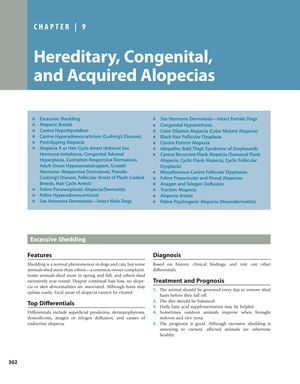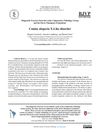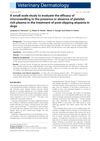Hereditary, Congenital, and Acquired Alopecias
September 2016
in “
Elsevier eBooks
”
alopecia canine hypothyroidism levothyroxine canine hyperadrenocorticism Cushing's Disease postclipping alopecia Alopecia X feline paraneoplastic alopecia sex hormone dermatosis congenital hypotrichosis follicular dysplasias psychogenic alopecia behavior-modifying drugs hair loss thyroid hormone replacement Cushing's stress-related hair loss

TLDR Different types of hair loss in dogs and cats have various causes and treatments, with outcomes ranging from good to uncertain.
The document from 2017 provides an overview of various types of alopecia in dogs and cats, including hereditary, congenital, and acquired forms. It discusses conditions such as canine hypothyroidism, which can cause alopecia and is treatable with levothyroxine, and canine hyperadrenocorticism (Cushing's Disease), which leads to symptoms like alopecia and has a prognosis of around 2.5 years post-diagnosis. Postclipping Alopecia, Alopecia X, and Feline Paraneoplastic Alopecia/Dermatitis are also covered, with treatments ranging from observation to medical therapies, and prognoses varying from good to poor. Other conditions like sex hormone dermatosis, congenital hypotrichosis, and various follicular dysplasias are mentioned, with treatments mainly addressing secondary infections and cosmetic concerns. Psychogenic alopecia in cats, caused by excessive grooming due to stress, is diagnosed by ruling out other causes and treated by addressing the stressor and possibly using behavior-modifying drugs, although the prognosis is variable. Overall, while some alopecias have effective treatments and good prognoses, others are primarily cosmetic issues or have guarded prognoses depending on the underlying cause.



